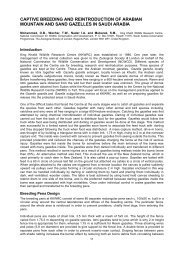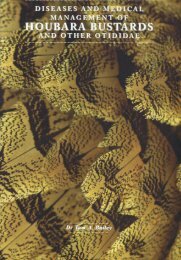His Highness Sheikh Zayed bin Sultan Al Nahyan - Wildlife Middle ...
His Highness Sheikh Zayed bin Sultan Al Nahyan - Wildlife Middle ...
His Highness Sheikh Zayed bin Sultan Al Nahyan - Wildlife Middle ...
Create successful ePaper yourself
Turn your PDF publications into a flip-book with our unique Google optimized e-Paper software.
9<br />
Artificial nests experiment in Mongolia 2004:<br />
success again.<br />
E. Potapov 1, S. Gombobaatar 2, D. Sumiya 2, O.<br />
Shagdarsuren 2, N. Fox 1.<br />
1The Falcon Research Institute, IWC Ltd, 2Faculty of<br />
Biology, Mongolian National University.<br />
As was reported in a previous issue of Falco<br />
(Potapov et al. 2003) in 2002, 98 artificial nest platforms<br />
were established in the Central Mongolian Steppe. The<br />
habitat is flat Mongolian steppe surrounded by mountains<br />
on one side and undulating steppe on the other. An<br />
additional 20 nests were set in the experimental study area<br />
in the autumn of 2003 and the replacement of 5 platforms<br />
destroyed by vandalism (1) and by livestock (4) bringing a<br />
total of 118 active platforms in 2004 with expansion of the<br />
area from 490.84 km2 to 540.25 km2. The platforms were<br />
established in the year of the Brandt’s vole (Microtus<br />
brandtii) plague of 2002. The vole population was<br />
monitored by counting the number of vole burrows and<br />
colonies within 100 m diameter around 13 nest platforms<br />
selected at more or less even distances from each other. In<br />
2003 the vole population collapsed (see Figures 1, 2), but<br />
nevertheless the Sakers, as well as Upland Buzzards started<br />
to occupy nest platforms. In 2003 a total of 4 pairs of Sakers<br />
and 29 Buzzards produced 10 (out of 10 eggs) and 41<br />
fledged young respectively. In 2004 the voles further<br />
decreased in numbers. Instead some Daurian Sousliks and<br />
Mongolian Gerbils started to be registered in small<br />
numbers. The total numbers of colonies of voles have<br />
increased in 2004 compared to 2003, but the number of<br />
active burrows per colony went down, i.e. the vole<br />
population became less concentrated. Nevertheless the<br />
Saker and Upland Buzzard numbers increased to a total of 5<br />
pairs of Sakers and 27 pairs of Buzzards producing 8 (out of<br />
21 eggs) and 48 fledged young respectively. The relative<br />
low breeding success of the Sakers was reported due to<br />
strong cold winds at the end of May-June, resulting in 2<br />
deserted clutches (total 6 eggs), one un-hatched egg and 1<br />
dead chick. Causes of loss of 3 eggs or chicks are unknown.<br />
The breeding density of Sakers increased from 0 in<br />
2002 to of 8.1 pairs per 1000 km2 in 2003 and in 2004<br />
reached 9.25 pairs per 1000 km2. This is unprecedented<br />
figures in terms of density. No such density was ever<br />
reported before in un-managed habitat. This by far<br />
exceeds the figure 2.5 pairs per 1000 km2 - the average<br />
density for Mongolian typical steppes measured in several<br />
study areas monitored in 1998-2004 (Shagdarsuren et al.<br />
2001). It is also surprisingly higher than the density<br />
recorded in an adjoining study area in 2003 – below 1.3<br />
pairs per 1000 km2 and in 2004 - 1.8 pairs per 1000 km2. Buzzards increased in density from 8.1 pairs per 1000 km2 in 2002 to 59.1 and 50.0 pairs per 1000 km2 in 2003 and<br />
2004 respectively. It appears that the number of Upland<br />
Buzzards reached its carrying capacity levels at the bottom<br />
level of numbers of voles.<br />
It is evident from the experiment that the providing<br />
of artificial nest substrates is beneficial to both Sakers and<br />
Upland Buzzards, and it also appears that both species are<br />
Figure 1. Number of vole burrows in 100 m circle and number of<br />
breeding Sakers and Upland Buzzards in the study area.<br />
Figure 2. Breeding succes of Sakers and Upland Buzzards and the<br />
number of active vole burrows in 100 m circle accross the years.<br />
nest site limited in the flat steppe landscape. Providing that<br />
the vole population decreased almost to zero, the resulting<br />
density is probably the actual limit, which is determined not<br />
by food supply, but by intrinsic behavioural mechanisms.<br />
Low food supply is probably the reason why the breeding<br />
success of the Sakers breeding in such density at nest<br />
platforms was lower than that of the surrounding area.<br />
References<br />
E. Potapov, D. Sumya, O. Shagdarsuren, S. Gombobaatar, I.<br />
Karyakin, and N. Fox .2003. Saker farming in wild<br />
habitats: progress to date. Falco 22: 5-7.<br />
Photo by S. Gombobaatar




